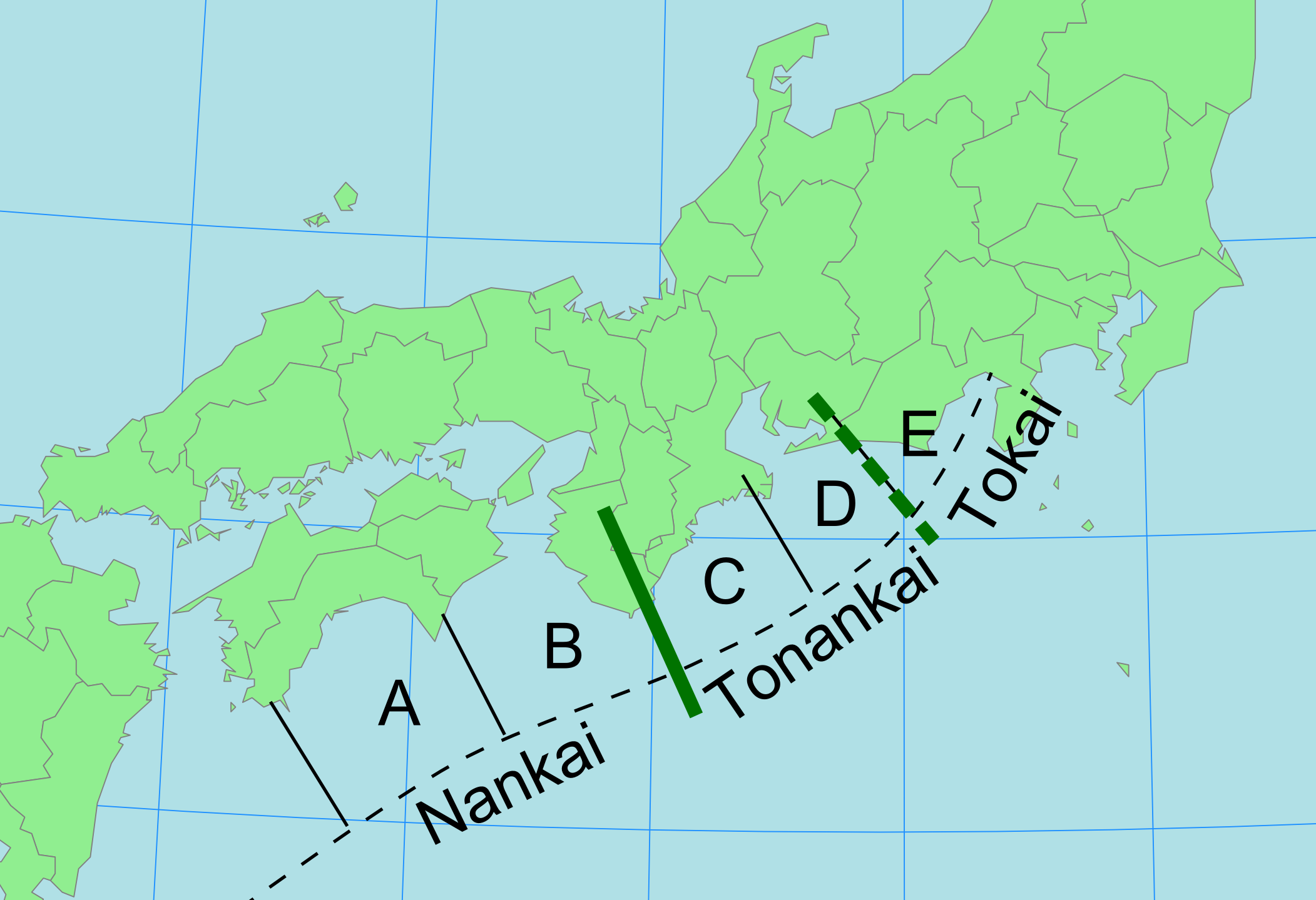Nankai Earthquakes on:
[Wikipedia]
[Google]
[Amazon]
 The are major
The are major
 The are major
The are major megathrust earthquake
Megathrust earthquakes occur at convergent plate boundaries, where one tectonic plate is forced underneath another. The earthquakes are caused by slip along the thrust fault that forms the contact between the two plates. These interplate earthqua ...
s that affect the Nankaidō
is a Japanese geographical term. It means both an ancient division of the country and the main road running through it. The road connected provincial capitals in this region. It was part of the Gokishichidō system.
The ''Nankaidō'' encompass ...
(Southern Sea Circuit) region of Japan
Japan ( ja, 日本, or , and formally , ''Nihonkoku'') is an island country in East Asia. It is situated in the northwest Pacific Ocean, and is bordered on the west by the Sea of Japan, while extending from the Sea of Okhotsk in the north ...
, west of the Tōnankai region (Southeastern Sea) and Tōkai region
The is a subregion of the Chūbu region and Kansai region in Japan that runs along the Pacific Ocean. The name comes from the Tōkaidō, one of the Edo Five Routes. Because Tōkai is a sub-region and is not officially classified, there is s ...
(Eastern Sea), and are caused by ruptures in the Nankai zone of the Nankai megathrust
The is a submarine Trough (geology), trough located south of the Nankaidō region of Japan's island of Honshu, extending approximately offshore. The underlying Fault (geology), fault, the ''Nankai megathrust,'' is the source of the devastating ...
, specifically segments A and/or B. They occur with a return period A return period, also known as a recurrence interval or repeat interval, is an average time or an estimated average time between events such as earthquakes, floods, landslides, or river discharge flows to occur.
It is a statistical measurement typ ...
of 100 to 200 years, and there is a high probability of one in the 21st century, as the most recent was the 1946 Nankaidō earthquake. These have high destructive potential, and thus are a focus of earthquake preparation.These are a class of Nankai megathrust earthquakes, frequently occurring in combination with, or following, a rupture of segments C and/or D (Tōnankai zone, yielding Tōnankai earthquakes) and sometimes segment E (Tōkai zone, yielding Tōkai earthquakes
The Tōkai earthquakes () are major earthquakes that have occurred regularly with a return period of 100 to 150 years in the Tōkai region of Japan. The Tōkai segment has been struck by earthquakes in 1498, 1605, 1707, 1854, and 1923. Given the hi ...
). They are also known as .
History
Historical Nankai earthquakes are as follows; some of these coincided with or followed earthquakes in the Tōnankai or Tōkai zones, and the 1498 Meiō Nankaidō earthquake may or may not have involved the Nankai zone: * 684 Hakuho Nankai earthquake * 887 Ninna Nankai earthquake * 1099 Kōwa Nankaido earthquake * 1361 Shōhei Nankaido earthquake *1605 Keichō Nankaido earthquake
Sixteen or 16 may refer to:
*16 (number), the natural number following 15 and preceding 17
*one of the years 16 BC, AD 16, 1916, 2016
Films
* '' Pathinaaru'' or ''Sixteen'', a 2010 Tamil film
* ''Sixteen'' (1943 film), a 1943 Argentine film di ...
(also Tōnankai: A+B+C+D)
* 1707 Hōei earthquake (also Tōnankai and Tōkai: A+B+C+D+E)
* 1854 Ansei-Nankai earthquake (following 1854 Ansei-Tōkai earthquake the previous day)
* 1946 Nankaidō earthquake (following 1944 Tōnankai earthquake
The 1944 Tōnankai earthquake occurred at 13:35 local time (04:35 UTC) on 7 December. It had an estimated magnitude of 8.1 on the moment magnitude scale (making it the strongest known earthquake of 1944) and a maximum felt intensity of greater th ...
)
References
{{unreferenced, date=July 2014 Megathrust earthquakes in Japan Nankaido Earthquake clusters, swarms, and sequences